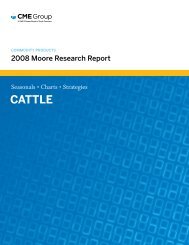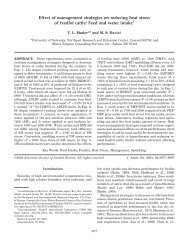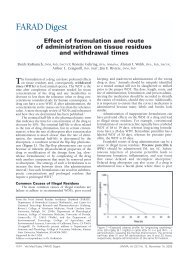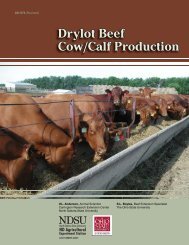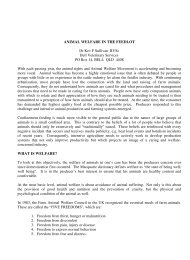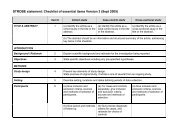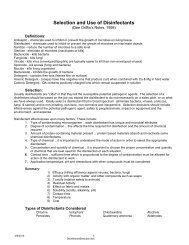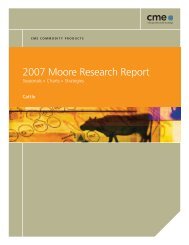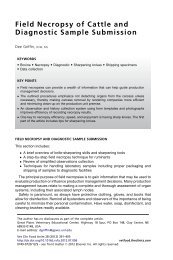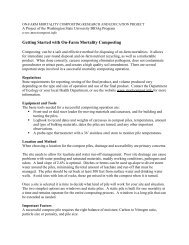CRIMES WITHOUT CONSEQUENCES - gpvec
CRIMES WITHOUT CONSEQUENCES - gpvec
CRIMES WITHOUT CONSEQUENCES - gpvec
You also want an ePaper? Increase the reach of your titles
YUMPU automatically turns print PDFs into web optimized ePapers that Google loves.
•<br />
•<br />
Crimes Without ConsequenCes<br />
One employee hit the hog from the floor [with captive bolt] and it did not stun<br />
the hog, then another employee that was not trained hit it from on top of the<br />
chute with the mechanical captive bolt stunner and it did not stun the animal.<br />
The third employee was trained but the stunner miss fired two times and then it<br />
hit but the animal went to its front knees and was not completely stunned, then<br />
the employee got on the floor and hit the animal again; this time it stunned the<br />
animal. 122<br />
While observing the stunning operation on a bovine steer, the method used (a<br />
22 caliber bullet to the brain) did not effectively render the animal unconscious<br />
prior to being shackled. It took 5 more bullets to complete the stunning. 123<br />
Humane handling of disabled animals<br />
As of January 12, 2004, U.S. slaughter plants are prohibited from slaughtering nonambulatory<br />
disabled cattle for human consumption. 124 However, disabled animals other<br />
than cattle still may be slaughtered, and disabled cattle may continue to be unloaded at<br />
slaughter facilities. In addition, cattle arriving at a plant in an ambulatory state may go<br />
down while on the grounds of the establishment. 125 Federal regulations require: “Disabled<br />
animals and other animals unable to move shall be separated from normal ambulatory<br />
animals and placed in the covered pen provided for in Sec. 313.1(c).” 126 They also state:<br />
“The dragging of disabled animals and other animals unable to move, while conscious,<br />
is prohibited.” 127 Following are examples from federal NRs of failure to handle disabled/<br />
downed animals in a humane manner:<br />
•<br />
•<br />
While walking toward the holding pens to take the temperature of a downer cow,<br />
I observed three persons forcing the downer animal to get up with a rope and<br />
one electric prod. The animal was bellowing and kicking the pen’s rods as [the<br />
animal] was forced by establishment employees but it could not get up because<br />
of an open wound in the leg. 128<br />
This morning your employee informed me of a vehicle arriving with three<br />
disabled cows in it…. I noticed there was no equipment suitable for humanely<br />
moving the disabled livestock without the animal being dragged. I then asked<br />
the driver being the only one around how he gets the animals off the truck and<br />
his reply was he pulls them with a rope. I then explained to him the humane<br />
procedure and showed him the FSIS directive 6900.1. He laughed but did not<br />
move the animals. 129<br />
122 NR issued to plant #02325M on November 19, 2003.<br />
123 NR issued to plant #15768M on September 10, 2003.<br />
124 Federal Register , Vol. 69, No. 7, January 12, 2004, pp. 1862-1874. Interim rule of January 12, 2004 was<br />
affirmed with amendments in Federal Register notice of July 13, 2007 to be effective October 1, 2007. Federal<br />
Register, Vol. 72, No. 134, July 13, 2007, pp. 38700.<br />
125 FSIS inspection personnel may determine on a case-by-case basis the disposition of cattle that go down after<br />
they have passed ante-mortem inspection. Moreover, non-ambulatory veal calves may be held for treatment.<br />
Federal Register, Vol. 72, No. 134, July 13, 2007, p. 38700.<br />
126 9 CFR 313.2(d)(1).<br />
127 9 CFR 313.2(d)(2).<br />
128 NR issued to plant #19751M on November 4, 2003.<br />
129 NR issued to plant #04470M on October 23, 2003.<br />
44




